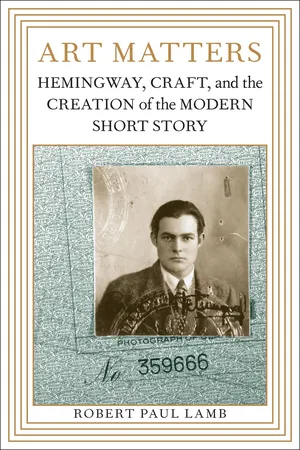
Art Matters
Hemingway, Craft, and the Creation of the Modern Short Story
- 296 pages
- English
- ePUB (mobile friendly)
- Available on iOS & Android
About this book
In Art Matters, Robert Paul Lamb provides the definitive study of Ernest Hemingway's short story aesthetics. Lamb locates Hemingway's art in literary historical contexts and explains what he learned from earlier artists, including Edgar Allan Poe, Paul Cézanne, Henry James, Guy de Maupassant, Anton Chekhov, Stephen Crane, Gertrude Stein, James Joyce, and Ezra Pound. Examining how Hemingway developed this inheritance, Lamb insightfully charts the evolution of the unique style and innovative techniques that would forever change the nature of short fiction.
Art Matters opens with an analysis of the authorial effacement Hemingway learned from Maupassant and Chekhov, followed by fresh perspectives on the author's famous use of concision and omission. Redefining literary impressionism and expressionism as alternative modes for depicting modern consciousness, Lamb demonstrates how Hemingway and Willa Cather learned these techniques from Crane and made them the foundation of their respective aesthetics. After examining the development of Hemingway's art of focalization, he clarifies what Hemingway really learned from Stein and delineates their different uses of repetition. Turning from techniques to formal elements, Art Matters anatomizes Hemingway's story openings and endings, analyzes how he created an entirely unprecedented role for fictional dialogue, explores his methods of characterization, and categorizes his settings in the fifty-three stories that comprise his most important work in the genre.
A major contribution to Hemingway scholarship and to the study of modernist fiction, Art Matters shows exactly how Hemingway's craft functions and argues persuasively for the importance of studies of articulated technique to any meaningful understanding of fiction and literary history. The book also develops vital new ways of understanding the short story genre as Lamb constructs a critical apparatus for analyzing the short story, introduces to a larger audience ideas taken from practicing storywriters, theorists, and critics, and coins new terms and concepts that enrich our understanding of the field.
Frequently asked questions
- Essential is ideal for learners and professionals who enjoy exploring a wide range of subjects. Access the Essential Library with 800,000+ trusted titles and best-sellers across business, personal growth, and the humanities. Includes unlimited reading time and Standard Read Aloud voice.
- Complete: Perfect for advanced learners and researchers needing full, unrestricted access. Unlock 1.4M+ books across hundreds of subjects, including academic and specialized titles. The Complete Plan also includes advanced features like Premium Read Aloud and Research Assistant.
Please note we cannot support devices running on iOS 13 and Android 7 or earlier. Learn more about using the app.
Information
Table of contents
- Cover Page
- Title Page
- Copyright Page
- Dedication
- Contents
- Preface
- Abbreviations
- Introduction: The Hemingway “Problem” and the Matter of Art
- 1. Historical Genre, Dispassionate Presentation, and Authorial Judgment: The Legacy of Maupassant and Chekhov
- 2. Minimizing Words and Maximizing Meaning: Suggestiveness, Concision, and Omission
- 3. Depicting Consciousness in Modern Fiction: Expressionism and Impressionism from Crane to Cather and Hemingway
- 4. Who Sees and Who Speaks: Hemingway’s Art of Focalization
- 5. Repetition and Juxtaposition: From Stein to Hemingway
- 6. Openings, Endings, and the Disjunctive Bump
- 7. The Normative Center, the Illustrative Stamp, and the Joycean Epiphany
- 8. The New Art of Constructive Dialogue: From James to Hemingway
- 9. Plot, Characterization, and Setting
- Coda: Hemingway’s Legacy
- Acknowledgments
- Appendix: Chronology of Hemingway’s Stories, 1923–1939
- Notes
- Works Cited
- Index